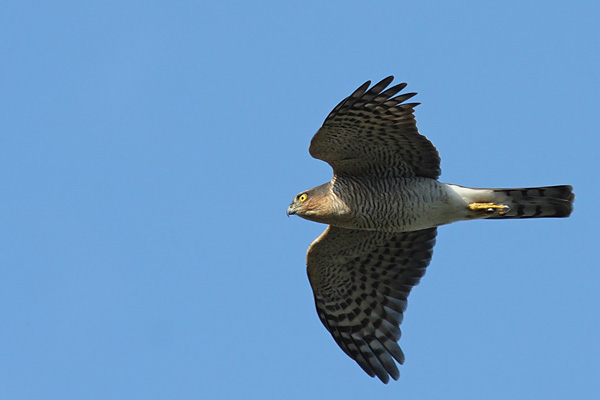I was taken round the reserve by Graham, another H&T volunteer who has many years of experience and knowledge, and was happy to share it with myself and Ben, another new volunteer. We were extremely lucky with the weather as Saturday's beautiful sunshine carried on which meant there were a few raptors about, using the thermals to their advantage. Our first spot was a sparrowhawk, though we were initially unsure as it was a fair distance away and its flying pattern was slightly out of character. It appeared to be catching insects in flight which is behaviour one would normally expect to see in a hobby, although the wings were the wrong shape for that. In the end, Graham managed to glimpse it in his scope and confirmed it as a sparrowhawk. Obviously one having a funny turn!

Image: www.splash.sussex.ac.uk
My birding knowledge has certainly expanded over the past couple of years but I am nowhere near competent in identification, so I'm always quite pleased when I spot a bird that is a bit trickier and correctly I.D. it straight away. This happened a few times on Sunday; one was a blackcap which generally isn't hard to identify but I don't see them very often; another was a female shoveler nestled among a group of mallards. We had some exciting sightings across the course of the day and the majority of these were at Hanger View where we spent quite a bit of time. Several kestrels were seen flying past and hovering over the North Brooks and one perched itself at the top of a berry-laden bush right in front of our position. It was a pleasure to observe this beautiful raptor bathed in sunlight, calmly preening itself and stretching its wings. I actually didn't realise kestrels had such vibrant orange legs until I saw this one through my binoculars.
A kingfisher made an appearance, the blue iridescence of its feathers contrasting against the red reeds it was hiding in. Another kestrel was dive-bombing a gliding buzzard in the distance. Two green sandpipers occupied the pond closest to us and we were able to watch them for at least an hour. At one point, they had a bit of a tiff and were chasing each other around in sweeping circles, half flying and half running. The shrubs closer to us were shaking with starlings and juvenile goldfinches, as well as a willow warbler. A couple of jays were picking acorns off the oaks and a green woodpecker flew from one side of the view and back. A cacophony of noise from the canada and greylag geese formed the afternoon's soundtrack. In the furthest pond, huddled between a group of lapwings were at least three dunlin, though the heat haze made it hard to focus on them, even through a scope.
By far the spot that I was most thrilled about was a grey wagtail. A few visitors had reported seeing a yellow wagtail or two nearby, but the grey appeared in the same pond as the green sandpipers and was easily distinguishable from its yellow cousin. I observed the comical dipping and lifting of the rump that gave the wagtails their name and saw how bright the yellow of its lower belly was. Even though the bird itself wasn't visible without optical assistance from where we stood, the sun kept catching that yellow belly as it moved about, pecking at the sand. It was quite unusual to see the grey wag in a location with still water; they are more commonly found near moving water, such as rivers.
)
Image: www.rspb.org.uk
The oak trees directly above us were full up with song birds, including blue and great tits, a nuthatch that could be heard tapping energetically, several long-tailed tits and at least two goldcrests, who's calls were first recognised by Gordon, another volunteer at the reserve who is particularly good with his bird sounds. It seemed as if the nearby robins never stopped singing.
I was pleasantly surprised with how much we saw and heard in that four-hour period. I'm very much aware that we are entering an exciting time of the year when it comes to birding, with many migrating waders and wildfowl returning from their summer holidays. In that respect, it is a brilliant time for me to be starting on hides and trails. In terms of the temperatures and the high chances of more rain, it isn't! I don't mind that though; if it means I have the chance to be out and about, learning more about wildlife and being able to share my passion with the public, then I'm definitely going to be happy.

I wish I had more time to spend outside doing stuff, my voluntary work involves writing for Notts Wildlife Trust.
ReplyDelete